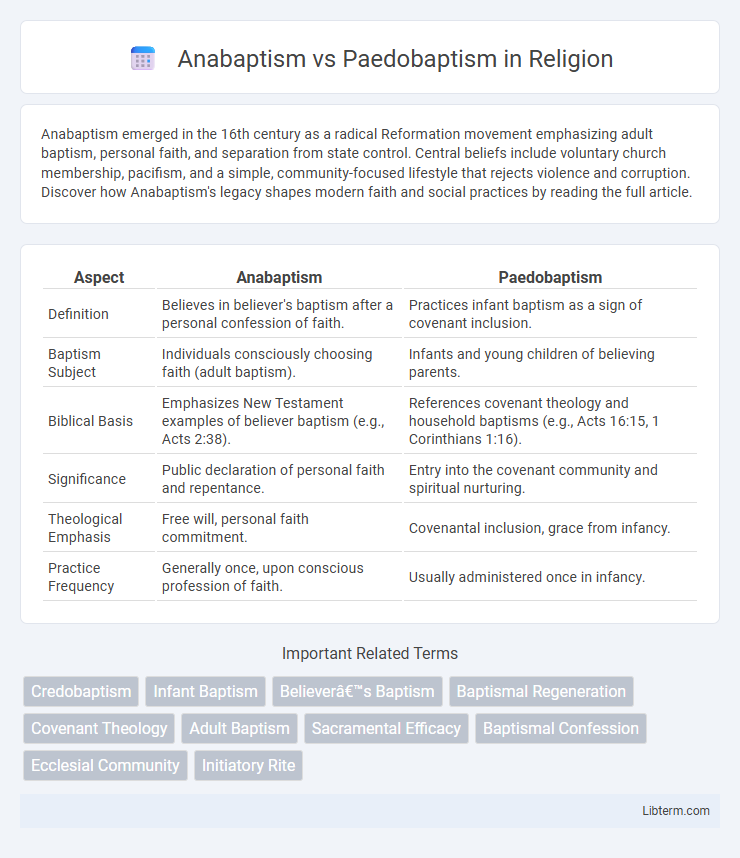Anabaptism emerged in the 16th century as a radical Reformation movement emphasizing adult baptism, personal faith, and separation from state control. Central beliefs include voluntary church membership, pacifism, and a simple, community-focused lifestyle that rejects violence and corruption. Discover how Anabaptism's legacy shapes modern faith and social practices by reading the full article.
Table of Comparison
| Aspect | Anabaptism | Paedobaptism |
|---|---|---|
| Definition | Believes in believer's baptism after a personal confession of faith. | Practices infant baptism as a sign of covenant inclusion. |
| Baptism Subject | Individuals consciously choosing faith (adult baptism). | Infants and young children of believing parents. |
| Biblical Basis | Emphasizes New Testament examples of believer baptism (e.g., Acts 2:38). | References covenant theology and household baptisms (e.g., Acts 16:15, 1 Corinthians 1:16). |
| Significance | Public declaration of personal faith and repentance. | Entry into the covenant community and spiritual nurturing. |
| Theological Emphasis | Free will, personal faith commitment. | Covenantal inclusion, grace from infancy. |
| Practice Frequency | Generally once, upon conscious profession of faith. | Usually administered once in infancy. |
Introduction to Anabaptism and Paedobaptism
Anabaptism emphasizes believer's baptism, asserting that only individuals capable of making a conscious confession of faith should be baptized, rejecting infant baptism practiced by Paedobaptism. Paedobaptism supports baptizing infants as a sign of the covenant, linking baptism to faith communities and familial inclusion rather than personal decision. These differing views reflect foundational theological distinctions regarding the nature of faith, covenant, and church membership in Christian traditions.
Historical Origins of Anabaptism
Anabaptism originated in the early 16th century during the Radical Reformation as a distinct movement opposing infant baptism, advocating for believers' baptism upon confession of faith. Key founders such as Conrad Grebel and Felix Manz rejected Paedobaptism, emphasizing voluntary church membership and a personal commitment to Christ. Anabaptists faced severe persecution from both Catholic and Protestant authorities due to their radical departure from established sacramental practices.
Development of Paedobaptism in Christian Traditions
Paedobaptism, the practice of infant baptism, developed prominently within early Christian traditions as a means of incorporating children into the covenant community, deeply rooted in theological interpretations of original sin and household baptisms in the New Testament. This sacramental view was institutionalized in branches like Roman Catholicism, Eastern Orthodoxy, and Protestant denominations such as Lutheranism and Anglicanism, emphasizing baptism's role in grace and initiation. The practice contrasts sharply with Anabaptism, which arose during the Radical Reformation, rejecting infant baptism in favor of believer's baptism based on personal faith and repentance, thereby promoting voluntary church membership.
Core Theological Differences
Anabaptism emphasizes believer's baptism, asserting that baptism should occur only upon a personal profession of faith, rejecting infant baptism as unscriptural. Paedobaptism supports infant baptism based on covenant theology, viewing baptism as a sign of inclusion in the covenant community similar to circumcision in the Old Testament. The core theological divergence centers on the subjects of baptism and its covenantal significance, shaping distinct ecclesiological identities.
Scriptural Foundations for Anabaptism
Anabaptism emphasizes believer's baptism based on explicit New Testament examples such as Acts 2:38 and Romans 6:3-4, advocating baptism only upon personal profession of faith. Key scriptural foundations include Jesus' command to baptize disciples (Matthew 28:19-20) and the recurring motif of baptism symbolizing individual repentance and regeneration. Anabaptists reject infant baptism due to the lack of biblical mandate for baptizing those incapable of conscious faith, differentiating their practice sharply from paedobaptism.
Scriptural Foundations for Paedobaptism
Paedobaptism is rooted in Scriptural passages emphasizing the covenantal nature of baptism, such as Acts 2:38-39, which links the baptismal promise to believers and their children. Passages like Colossians 2:11-12 illustrate baptism as a sign of the covenant, analogous to circumcision, applied to infants within believing families. The household baptisms recorded in Acts 16:15 and 1 Corinthians 1:16 provide practical precedents supporting infant inclusion based on family faith contexts.
Baptismal Practices and Rituals Compared
Anabaptism emphasizes believer's baptism, which requires a personal profession of faith before the ritual is performed, often through full immersion as a symbolic act of repentance. In contrast, Paedobaptism practices infant baptism, typically using sprinkling or pouring, as a sign of covenant inclusion and spiritual cleansing. These differing rites reflect divergent theological views on the role of faith, covenant, and community membership in the baptismal sacrament.
Impact on Christian Community and Identity
Anabaptism emphasizes believer's baptism, reinforcing a voluntary, conscious faith commitment that shapes a distinct Christian community identity centered on discipleship and separation from secular society. Paedobaptism integrates infants into the covenant community, fostering a sense of inherited faith identity and continuity within the broader church tradition. These contrasting baptismal practices influence ecclesial structures, community boundaries, and theological self-understanding across Christian denominations.
Contemporary Debates and Perspectives
Contemporary debates on Anabaptism versus Paedobaptism center on the theological legitimacy and biblical interpretation of believer's baptism versus infant baptism, with Anabaptists emphasizing conscious faith and Paedobaptists highlighting covenantal inclusion. Key issues include the nature of original sin, church membership, and the role of baptism as a sign of faith or covenantal promise. Modern scholars and denominations continue to engage with historical confessions and scriptural exegesis, influencing practices in Protestant, Catholic, and Anabaptist communities worldwide.
Conclusion: Key Takeaways and Ongoing Dialogue
Anabaptism emphasizes believer's baptism, asserting that baptism should follow a conscious profession of faith, while Paedobaptism practices infant baptism based on covenant theology and the inclusion of children in the faith community. Both traditions hold baptism as a significant sacrament but differ fundamentally on its timing and recipients, reflecting deeper theological and ecclesiological convictions. Ongoing dialogue continues to explore these differences, seeking mutual understanding and respect within the broader Christian context.
Anabaptism Infographic

 libterm.com
libterm.com